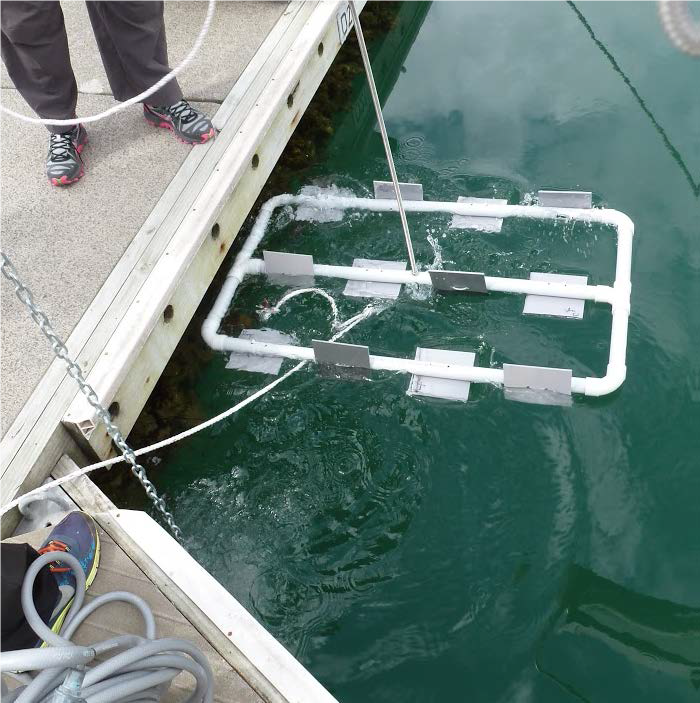Optimising settlement arrays for surveillance of non-native biofouling species

Field trials were implemented in Waitemata Harbour to test different configurations of settlement surfaces for sampling non-native biofouling species. The trials examined the influences of surface orientation (horizontal vs. vertical), surface texture (smooth vs. rough) and the presence of thin-layer antifouling coatings (to simulate aged paints) on the diversity of non-native species that was sampled.
What we found:
Several characteristics of the settlement surfaces enhanced the capture of non-native species. In particular:
- More non-native species were found on horizontal, shaded surfaces than on sunlit surfaces
- A combination of vertical and horizontal surfaces sampled the greatest diversity of non-native species as, collectively, they captured both shade-seeking species, such as ascidians and bryozoans, and those that require light (e.g., macroalgae)
- Biofouling on the thin antifouling coatings was dominated by non-native species, but on average, more non-native species occurred on surfaces without the toxic coatings
- Larger numbers of non-native species were sampled in summer than in winter
Nineteen non-native species were recorded on the surfaces, including the Mediterranean fanworm (Sabella spallanzanii) and clubbed tunicate (Styela clava). Two species - the colonial ascidian Symplegma brakenheilmi and the bryozoan Celleporaria umbonatoidea - were detected for the first time in Auckland.
Arrays of settlement surfaces can be used to complement other forms of surveillance for non-native marine species such as diver surveys or pile scrapes. Large numbers of surfaces will be required to optimise the arrays for early detection of new non-native species. However, these methods can be used to sample areas that divers cannot access and to capture early life-stages of biofouling species.
How is this research being used?
In a series of companion study, we are investigating the use of community genomic approaches ('metagenomics') to identify the range of organisms present on the arrays. These methods, which involve mass DNA or RNA sequencing have potential for more rapid identification of species in complex biological samples and may, in time, reduce the costs of processing, thereby allowing much larger numbers of samples to be collected.
 [Image: Leigh Tait, NIWA] Settlement plate with a thin-layer antifouling coating showing a bryozoan colony over which a range of other species have recruited (inset). |
Additional reading:
- Tait, L. Inglis, G., Seaward, K. (2018). Enhancing passive sampling tools for detecting marine bioinvasions. Marine Pollution Bulletin 128: 41-50.
- Tait, L., Inglis, G.J., Seaward, K., Spong, K., Wilkens, S.L., (2016) Optimising settlement arrays for surveillance of non-indigenous species. Results and recommendations following settlement array field trials. Prepared for the Ministry of Primary Industries. MPI Technical Paper No:2016/70 [PDF 3.0 MB]
- Tait, L., Inglis, G. (2016). Optimising settlement arrays for surveillance of non-indigenous biofouling species: Literature review. MPI Technical paper No: 2016/71. 53 p. ISBN No: 978-1-77665-426-0 [PDF 661 kb]
Related content:
-
Floerl, O., Inglis, G. J., Peacock, L. and Plew, D. (2012). Efficacy of settlement plate arrays for marine pest surveillance. MPI Technical Paper No. 2012/16. Prepared for Surveillance and Investigation. Ministry for Primary Industries, Wellington. 87 pp. [PDF 1.0 MB]
-
von Ammon, U., Wood, S. A., Laroche, O., Zaiko, A., Tait, L., Lavery, S., Inglis, G. and Pochon, X. (2018). The impact of artificial surfaces on marine bacterial and eukaryotic biofouling assemblages: A high-throughput sequencing analysis. Marine Environmental Research 133: 57-66.
Key contacts:
| Leigh Tait | Graeme Inglis |
| Principal Investigator | Science Leader |
| NIWA | NIWA |
| [email protected] | [email protected] |